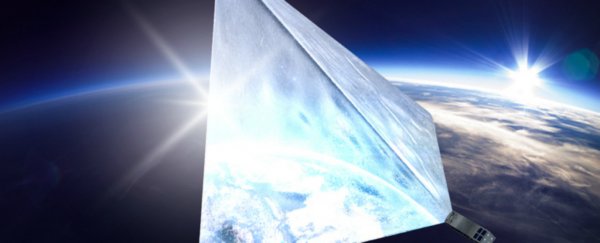Depending on where you are in the world and when, the brightest star in the night sky is likely to be the binary star Sirius, also known as Alpha Canis Majoris. But that could soon be about to change, if an amateur Russian satellite is launched mid-2016 as planned.
The satellite is called Mayak, or "beacon" in English, and it's designed to orbit opposite the Sun and reflect its light using giant sails, making it appear brighter to us than any other stars in the night sky - and, according to some reports, potentially even brighter than the Moon.
The satellite itself won't actually be doing any observations or scientific work, the goal of the project is quite simply to inspire humanity by creating an artificial 'star' that we can look up to, and the engineers behind it have already raised more than US$22,000 (1.7 million rubles) on Russian crowd-funding site, Boomstarter.
"We are sending a spacecraft into orbit that will be the brightest star in the sky, visible from any point on our planet," project leader Alexander Shaenko, head of the Contemporary Cosmonautics program at Moscow State Mechanical Engineering University, told Sputnik News.
"We want to show that space exploration is something exciting and interesting, but most importantly that today it is accessible to everybody who is interested."
Even though Shaenko is employed as an engineer, he's working on the Mayak project on the side, and the whole thing is essentially being run by enthusiasts, which will make it Russia's first amateur satellite to enter space if all goes to plan.
Mayak itself is only roughly the size of a loaf of bread, but it's designed to unfurl a 16-square-metre, triangular sail once it gets into orbit 600 km above the Earth, turning the whole thing into a giant, reflective pyramid.
According to the Boomstarter page, the sail is made of a thin polymer material, and the engineers are now working on an aerodynamic braking system for the satellite, which will allow it to move into lower orbit without using its engine, and help it to avoid space junk.
The Russian Federal Space Agency, Roscosmos, has now agreed to launch Mayak into space on board its Soyuz-2 rocket as early as July this year.
"Attracting young people to the field of cosmonautics is one of our priorities," a Roscosmos spokesperson told Sputnik News. "Roscosmos works seriously with universities and by supporting projects like Mayak we boost the motivation of students to work for Russian space rocket enterprises in the future."
There's still a lot of work to do before launch though - the team has to finish all the testing, and the engineers also want to build a model of the satellite to go on display in Moscow's Museum of Cosmonautics, so students can be inspired by it during the daytime as well.
But the delay might not be a bad thing, because there are concerns that this artificial star could get in the way for stargazers who want to see the real things, or even worse, scientists who need to filter out light in order to study the skies.
It's not yet clear how much of an issue this will be, but it's something that will hopefully be considered before the satellite is sent into Earth's orbit indefinitely. Because we all love to look at new objects in the night sky, but not if it interferes with all the natural beauty of space.
